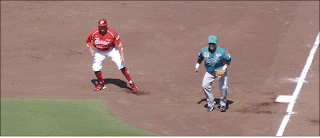The Delayed Steal (Part 3)
 |
The first baseman is not to blame on a delayed steal.
He will be looking home before the runner goes. |
In Part 2, I listed and explained what coaches should look for before giving the delayed steal sign to a runner at first base. If you read it, you’ll notice I didn’t say anything about mistakes made by the first baseman. That is because the first baseman is a complete non-factor in whether a delayed steal will work or not. That being said, it’s amazing how many times the defensive team (and coaches) will be critical of the first baseman after a successful delayed steal for not yelling that the runner was going. Their criticism is misdirected because if done correctly, a delayed steal will never be seen by a first baseman. A delayed steal works because of mistakes by the catcher and/or the middle infielders. To prevent a delayed steal, here are some simple things the catcher and middle infielders must do.
The Catcher
Stay alert. Catchers must first realize that a delayed steal is a possibility on every single pitch with a runner at first and must act accordingly. Do not get lazy and/or relax if nobody yells “RUNNER!” on the pitch. Stay in your “runners on base” stance so that you are ready to come up and throw.
Stand up to throw back. With no runners on base it is perfectly ok to drop to a knee to make throws back to the pitcher after the pitch. With runners on, get in the habit of always standing up after the pitch to throw the ball back. If you get in the habit of dropping to your knee(s), you are likely to get bitten by a delayed steal at some point.
Middle Infielders
 |
Positioning and staying alert immediately after
the pitch is key for the middle infielders
in preventing a delayed steal. |
Position correctly. A middle infielder should be close enough to the bag before the pitch to enable himself to get there in time for a straight steal as well as a delayed steal. This involves some knowledge of how quick they are. If the fielder is quick, they can afford to be a little farther from the bag. If he has slower feet, he may need to be closer before the pitch. Many coaches will not even put the delayed steal on if they consistently see that the middle infielders are close enough to the bag.
Double Peek. Middle infielders should never rely on others to inform them that the runner is straight stealing or stealing on a delay. To ensure this, both middle infielders need to peek twice at the runner at first base. The first peek glances at the runner as soon as the pitcher starts his delivery home after coming set. This peek checks for the straight steal. As soon as the ball crosses the hitting zone and is not hit, a second peek at the runner checks for the delayed steal. Two peeks anytime a runner is on first base. On every pitch. No exceptions.
Step to the bag. This is also mandatory and occurs in sync with the second peek explained above. As soon as the middle infielder sees that the pitch is not hit, he peeks again at the runner AND AT THE SAME TIME takes a step towards second base. The combination of these two peeks and the step towards second base immediately after the pitch will make sure the middle infielders are never caught napping on a delayed steal.







Leave a Reply